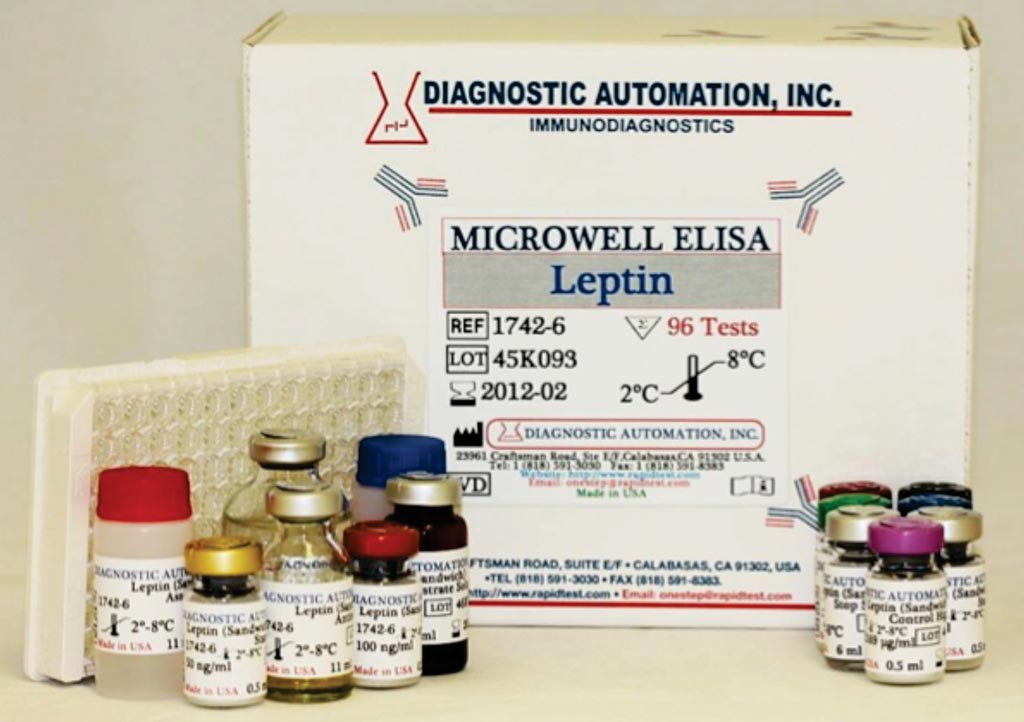Leptin to Adiponectin Ratio Predicts Metabolic Function in Obesity
By LabMedica International staff writers
Posted on 08 Aug 2018
There is an epidemic of obesity and the metabolic syndrome in the USA and across the world. Both entities are associated with high mortality, mainly as a result of cardiovascular disease. The epidemic of obesity has been paralleled by an increase in the incidence of chronic kidney disease.Posted on 08 Aug 2018
Leptin is a hormone predominantly made by adipose cells that helps to regulate energy balance by inhibiting hunger and adiponectin is a protein hormone, which is involved in regulating glucose levels as well as fatty acid breakdown. The ratio of leptin to adiponectin may be a useful surrogate biomarker for early obesity-related metabolic disorders, such as leptin resistance, insulin resistance and delayed postprandial triglyceride clearance.

Image: An ELISA for quantitative determination of leptin in human serum and plasma (Photo courtesy of Diagnostic Automation).
Scientists at the Arctic University of Norway (Tromsø, Norway) evaluated 50 adults with obesity and clinical or biochemical signs of metabolic disease and 17 healthy, normal-weight controls. Among the participants with obesity, 36 adults were considered to have metabolically healthy obesity (MHO; meeting no criteria for metabolic syndrome apart from waist circumference measurement) and 14 adults were considered to have metabolically dysregulated obesity (MDO; meeting at least two criteria for metabolic syndrome).
The investigators used an eight-hour oral fat tolerance test to measure postprandial triglyceride clearance and assessed insulin resistance via homeostatic model assessment of insulin resistance (HOMA-IR; cutoff value, 1.83). Indirect leptin resistance was also calculated as an indirect measure of resting energy expenditure to serum leptin ratio (cutoff value, 114.5). The team developed a leptin to adiponectin ratio receiver operating characteristics (ROC) curve to identify delayed triglyceride clearance, defined as less than 88.8% at six hours.
In the MHO group, 71.4%, 69.4% and 86.1% had delayed triglycerides (TG) clearance, insulin resistance (IR) and leptin resistance (LR), respectively; whereas in the MDO group this was detected in 85.7%, 71.4% and 91.7%, respectively. A combination of all three metabolic risk factors was found in 39.8% of the MHO and in 42.9% of the MDO patients. Receiver operating characteristics (ROC) analysis revealed that a cut-off value for the L:A ratio of >1.65 for the control group (PPV 1.0, NPV 0.91) and >3.65 for the obese subjects (PPV 0.86, NPV 0.48) predicted the delayed TG clearance with a good specificity and sensitivity. Detecting a combined risk with at least 2/3 metabolic risk factors, the ROC yielded the most suitable leptin: adiponectin ratio cut-off at >1.88.
Maria Arlen Larsen, PhD, the first author of the study, said, “We have previously showed a prolonged postprandial clearance of triglycerides in metabolically healthy obese adults, indicating metabolic disturbances in these apparently healthy subjects. It is of importance to detect individuals at high risk for further disease development, so that prophylactic actions can be taken. At this point, no clinical screening tools exist that are sensitive enough to detect early metabolic disturbances in metabolically healthy obesity.” The study was published on July 17, 2018, in the journal Nutrition, Metabolism & Cardiovascular Diseases.
Related Links:
Arctic University of Norway













